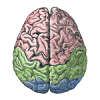8.3: Familiarity and Recognition Memory
- Page ID
- 12611
Stepping back now from the specific memory contributions of the hippocampus, we consider a broader perspective of how the hippocampal system fits into the larger space of human memory capacities. One of the most important questions that researchers have focused on here is whether the neocortex can contribute anything at all to single trial episodic memory. Does a single exposure to a given stimulus leave a big enough trace anywhere in the cortex so as to influence overt behavior? As noted previously, we feel confident that synapses throughout the brain are likely to be affected by every learning experience, but is neocortical learning simply too slow, and the representations too overlapping, to produce a behaviorally significant change from a single experience?
A large body of data suggests that indeed the neocortex can support episodic memory traces, but that they have very different properties compared to those supported by the hippocampus. Specifically, it seems that the perirhinal cortex can produce a useful familiarity signal, that indicates in a very coarse manner whether a given stimulus was experienced recently or not. This familiarity signal can be contrasted with the recollective memory signal provided by the hippocampus: a full explicit recall of the details of the previous episode when the item was last experienced. The familiarity signal is instead more like a single graded value that varies in intensity depending on how strongly familiar the item is. One hypothesis about the neural basis for this signal is the sharpness of the representations in perirhinal cortex -- single trials of learning in a generic cortical model leave measurable traces on the overall pattern of neural activity, such that the contrast between strongly active and more weakly active neurons is enhanced (Norman & O'Reilly, 2003). This results from the basic self-organizing learning dynamic we observed in the Learning Chapter, where the most strongly activated neurons strengthen their synaptic connections, and thus are better able to out-compete other neurons.
Interestingly, people can obtain subjective conscious access to this familiarity signal, and use it to make overt, conscious evaluations of how familiar they think an item is. The neural mechanism for this explicit readout of a sharpness signal has not been identified. This main challenge here is identifying why signals in perirhinal cortex are consciously accessible, while similar such signals in other neocortical areas do not appear to be accessible to consciousness (as we discuss in the next section).
This combination of hippocampal recall and perirhinal familiarity memory systems is called a dual process model of recognition memory, and after many years of controversy, it is now widely accepted in the field. Some of the data consistent with this dual process model include preserved familiarity signals in people with substantial hippocampal lesions, and a variety of neuroimaging and behavioral studies that have been able to distinguish between these two memory signals in various ways.
A subsequent revision will contain a dual-process memory model to explore at this point.


